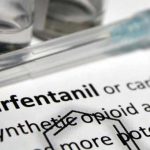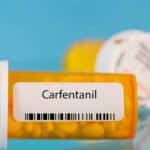- What Is Carfentanil?
- Signs Of Overdose
- Treating A Overdose
- What Is A Lethal Dose?
- How To Avoid A Overdose
Throughout the opioid crisis (also called the opioid epidemic), fentanyl has caused numerous drug overdose deaths. Many people assume it’s the most powerful opioid.
However, according to the United States Drug Enforcement Administration (DEA), there’s an opioid that’s 100 times more powerful than fentanyl: carfentanil. When ingested by humans, this drug poses an extremely high risk of fatal overdose.
What Is Carfentanil?
Carfentanil is a synthetic opioid that’s usually prescribed under the brand name Wildnil. It’s a fentanyl analog, which means it’s chemically similar to fentanyl. Veterinarians use it as a sedative for elephants and other large animals.
Although carfentanil is not approved for human use, some people have started ingesting it. Like other opioids, it can make you feel relaxed and happy, or “high.”
It can also have a number of negative side effects, including:
- anxiety
- depression
- trouble concentrating
- runny nose
- sweating
- muscle aches
Also, because the drug is so powerful, people who use it will likely overdose.
Signs & Symptoms Of Carfentanil Overdose
The most common signs of a carfentanil overdose include:
- drowsiness
- nausea and vomiting
- slowed or stopped breathing
- slowed or stopped heartbeat
- smaller pupils (also called “pinpoint pupils”)
- pale, bluish, cold, or clammy skin
- bluish lips or fingernails
- limp body
- loss of consciousness
In addition, you may find carfentanil in the area where the person overdosed. Carfentanil comes in multiple forms, including a tablet, powder, patch, spray, and blotter paper.
Do not touch the drug, as it can be absorbed through your skin. Even law enforcement officials and other professionals must take extreme caution when interacting with carfentanil.
How To Treat A Carfentanil Overdose
If someone you know experiences symptoms of a carfentanil overdose, call 911 right away. Lay the person on their side to reduce their risk of choking, and try to keep them awake.
If they inhaled the drug, make sure they have fresh air. If they ingested the drug and have not lost consciousness, use cool water to wash out their mouth and eyes.
Also, administer naloxone if you have it. Naloxone is a medication commonly sold under the brand name Narcan. It can quickly reverse the effects of an opioid overdose.
Because carfentanil is so potent, you may need to administer multiple doses of naloxone.
Talk to your healthcare provider or pharmacist for more information on getting and using the drug. It’s available at most pharmacies without a prescription.
When first responders arrive, they will administer more naloxone if needed. They will then closely monitor the person and help them become stable.
What Is Carfentanil’s Lethal Dose?
Researchers have not determined carfentanil’s lethal dose range. However, as mentioned above, the drug is 100 times more powerful than fentanyl. Fentanyl can be lethal at about 2 milligrams. This suggests that even an extremely small dose of carfentanil could cause death.
How To Avoid A Carfentanil Overdose
The only way to avoid a carfentanil overdose is to avoid abusing drugs. In other words, only use drugs as prescribed by your doctor.
In addition, never buy drugs from the illegal drug market.
Even if you don’t seek out carfentanil, you may unknowingly ingest it. That’s because many drug dealers secretly add the drug to other substances, including illicit drugs (such as heroin and cocaine) and prescription opioids (such as oxycodone and hydromorphone).
In most cases, they do this to reduce production costs, as carfentanil and other fentanyl-related compounds are very cheap to make.
If you feel unable to stop abusing carfentanil or other drugs, you may have substance use disorder (also called drug addiction).
This disease causes symptoms such as:
- intense drug cravings
- tolerance (needing increasingly larger or more frequent doses of a drug to feel the desired effects)
- physical dependence (experiencing withdrawal symptoms, such as sweating or anxiety, when you don’t use drugs)
- mood swings
- trouble keeping up with responsibilities at work, school, or home
- loss of interest in activities once enjoyed
People who live with substance use disorder should seek help at a drug abuse treatment program. According to the Centers for Disease Control and Prevention (CDC), an effective treatment program for opioid addiction typically includes behavioral therapy and medications.
If you or someone you love struggles with carfentanil or other drugs, please contact Northeast Addictions Treatment Center. Our healthcare providers offer personalized, evidence-based treatments to help you and your loved ones stay drug-free.
Sources
Written by
Northeast Addition Editorial Team
©2024 Northeast Addition Center | All Rights Reserved
This page does not provide medical advice.


